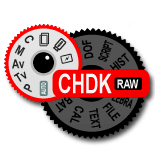It seems like we’ll be waiting some time for the camera that takes the view you saw and makes it into a picture on its own. On the way to this goal a number of problems turned up that were solved on the computer. Low dynamic range (high contrast) was improved by bracketing and enfusing; barrelling (radial distortion) by determining the Dersch coefficients (left) and applying a counter-distortion; and chromatic aberration by measuring sets of aberrations (below right) and remapping the colour channels so that they now matched each other. What we might also like to do is process RAW images, save copies of the originals, both as JPG and in a sturdier format such as PNG. And while we’re moving the formats around, taking care that the EXIF data gets transferred too, perhaps a little extra data could be included. Then some postprocessing like Advanced Tone Mapping. And finally, thumbnailing and sharpening so that the images can be experimented with. Oh dear, it seems like Christmas is rather early this year. Continue reading
Tag Archives: RAW photos
What CHDK has done for me
After the serendipity of finding CHDK, I set to work on my projects. This is how they turned out.
Grid overlay. Easy, almost trivial to implement, but it’s a great help just having a couple of lines on the screen to check that your horizontal is what you think it is. Continue reading
Hacking the Canons: CHDK
CHDK is a set of tools allowing the user full control over the operation of a large number of the cheaper Canon point&shoot cameras. After all, a camera nowadays is more that a box with a hole in it; everything is, of course, controlled by a microprocessor. With suitable access to the processor, the camera becomes like any other universal machine and can be programmed to do what you like with it. I can vividly remember my disappointment when I thought that I could use the time delay function for a sort of limited time lapse, and all the camera did was wait for the set time and take the ten shots in quick succession. If the camera can count to 30 once, why not continue the process. Continue reading


